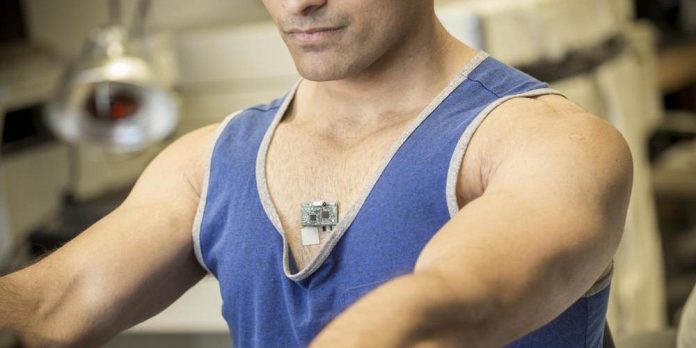Nowadays, wearable technology taking place in various sectors like computing, medical, etc. Wearable technology is nothing but electronic gadgets that can be worn on the body. It may be like an accessory or clothing material embedded with smart sensors. Wearable technology, such as smartphones, mobile applications, and computing, is now becoming famous. One of its major features is hands-free monitoring. Artificial intelligence and big data are some of its most appealing applications.
Well, researchers from the University of California San Diego invented a new wearable device. This is the first flexible device to detect biochemical and electrical signals inside the human body.
This device is known as the Chem-Phys patch. It consists of a flexible set of sensors and a small electronic board. This Chem-Phys patch is a flexible wearable device that records an electrocardiogram (EKG: the process of recording the electrical activity of the heart over a period of time using electrodes placed on the skin). Heart signals and track lactate levels (a biochemical that is a marker of tangible effort in real-time).
Working of Chem-Phys patch:
The device, known as the Chem-Phys patch, can be worn on the chest. It establishes communication wirelessly with the help of a smartphone, smartwatch, or computing devices. It can also transmit the data from biochemical and electrical signals along with Bluetooth.
Discovery of Chem-Phys Patch:
Nano-engineers and electrical engineers from the University of California worked combined to build up the device. Their goal was to build such a wearable tricorder-like device that can constantly measure an overall set of chemical, physical, and electrophysiological signals during the day. After that, the team’s biggest task was making sure that signals from two different sensors could not interfere with each other.
This new tiny wearable device was made by screen printing onto a thin, flexible polymer sheet. An electrode to sense lactate was printed in the center of the patch, with two EKG electrodes bracketing it to the left and the right. The researchers also had to ensure the EKG sensors were isolated from the lactate sensor. Researchers added a printed layer of soft water-repelling silicone rubber to the patch and configured it to keep the sweat away from the EKG electrodes but not the lactate sensor.
After that, the sensor is connected to a small custom-printed circuit board equipped with a microcontroller and a Bluetooth Low Energy chip.
Dr. Kevin Patrick, a physician and director of the Centre for Wireless and Population Health Systems at UC San Diego, explained, “The ability to sense both EKG and lactate in a small wearable sensor could provide benefits in a variety of areas. There would certainly be interest in the sports medicine community about how this type of sensing could help optimize training regimens for elite athletes. The ability to concurrently assess EKG and lactate could also open up some interesting possibilities for preventing and/or managing individuals with cardiovascular disease.”
Testing of Chem-Phys patch:
This patch was tested on three different males. Researchers asked them to wear the device on their chest, alongside the base of their Sternum (the breast bone), while doing 15 to 30 minutes of continuous activity on a stationary bike. After this, scientists get an outcome as data collected by the EKG electrodes on the patch is approximately similar to the data collected by a commercial wristband. The locate biosensor collects the data during increasing intensity workouts in other studies.
Patrick Mercier, Professor at the University of California San Diego, said, “One of the overarching goals of our research is to build a wearable tricorder-like device that can measure simultaneously a whole suite of chemical, physical and electrophysiological signals continuously throughout the day.”
“This research represents an important first step to show this may be possible.”
Features of Chem-Phys patch:
- The device can detect both biochemical and electrical signals in the body at the same time.
- It is made by screen printing onto a thin and flexible polymer sheet.
Applications of Chem-Phys patch:
- This wearable chemical-electrophysiological hybrid biosensing system is for real-time health and fitness monitoring.
- It may be useful for athletes wanting to improve performance.
- It helps physicians monitor patients with heart disease.
Journal Reference
- Imani, S., Bandodkar, A., Mohan, A., et al. A wearable chemical–electrophysiological hybrid biosensing system for real-time health and fitness monitoring. Nature Communications 7, 11650 (2016). DOI: 10.1038/ncomms11650
